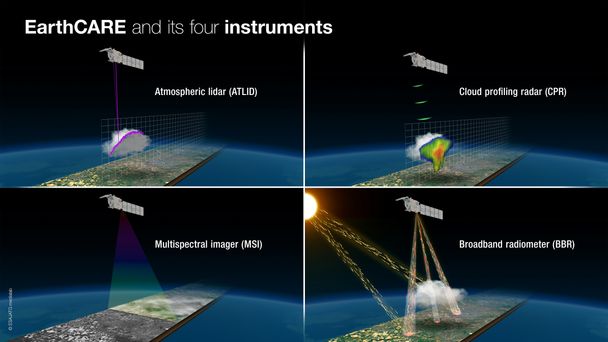EarthCARE scientists put their heads in the clouds to explore their climate impact

Some days you wish clouds would just go away. Yet from a drizzly grey blanket to the fearsome ice-white thunderhead, these celestial water reservoirs regulate our climate. Clouds are surprisingly little understood but that's about to change. The European Space Agency’s (ESA) soon-to-be-launched, Airbus-built EarthCARE satellite could help scientists shed new light on their complexity.
What’s in a cloud?
Clouds are a key regulator of the Earth’s temperature, heating or cooling it, but their climate impact can vary according to their composition and their interaction with solar and terrestrial radiation, either reflecting or trapping it. They are so much a part of our daily lives that we can easily overlook the complexity behind their beauty. Clouds constantly change shape as they move across the sky. The millions of tiny particles they contain - mostly water droplets and ice crystals - are constantly in motion too. They fuse, freeze or melt, evaporate and condense, determining cloud formation and when and where it rains. These rapidly changing parameters make cloud modelling challenging - unless we can see them clearly.
Clouds are classified into ten main types according to their shape and altitude. “As they permanently cover about two-thirds of the planet, clouds’ climate impact is enormous," says ESA EarthCARE mission scientist Thorsten Fehr. “Currently, clouds have a cooling effect on the climate, but this may decrease in the future leading to an additional warming effect”. EarthCARE will provide scientists with observations on a global scale, including clouds’ vertical and horizontal profiles, their height, thickness, precipitation and for the first time from space, their fall velocity. “We will literally be able to see inside the clouds to get a better understanding of their behaviour and structure, and how they form and dissipate, improving our understanding of clouds and their impact on climate,” the mission scientist says.

© Airbus (link to image)
The challenge of cloud digitisation
However, cloud-related data used in current climate models is not yet sophisticated enough to account for all the effects of clouds. “Scientists need more realistic cloud representations to improve climate modelling,” says Fehr. “That’s what EarthCARE will enable them to do.”
Once in orbit, EarthCARE’s state-of-the-art monitoring instruments will analyse the composition and distribution of aerosols and clouds, their structure and behaviour, and how they interact with solar radiation and the Earth’s surface energy.
Researchers will use the satellite's findings to model how the parameters interact, opening the way to new climate change predictions based on comprehensive cloud observations.

© ESA (link to image)
Warming or cooling? That is the question!
However, the full picture will not be complete until scientists have access to data about how clouds reflect solar radiation back into space or trap infrared radiation from the Earth’s surface. The balance between the two directly impacts atmospheric and surface temperatures.
“Clouds have both a cooling and a warming effect, but each type exerts a different influence,” says Fehr. “Their height determines their temperature, which affects the amount of energy they emit, while aerosols and other environmental conditions determine how reflective they are.”
Low, compact cumulus clouds, usually made up of many water droplets, can reflect a lot of sunlight. They help to cool the Earth’s surface by reflecting sunlight back into space. On the other hand, high-altitude clouds are cold and emit heat radiation back towards Earth’s surface, warming the atmosphere. If the number of high clouds increases while the number of low clouds decreases, the temperature curve could rise.
New data from EarthCARE will enable researchers to improve climate predictions and to better measure the Earth’s radiation budget, which is the balance between incoming solar energy and outgoing radiation from Earth.
For those who predict the Earth’s climate
The Intergovernmental Panel on Climate Change (IPCC) has confirmed that the rise in temperatures observed since the mid-20th century is likely to be caused by human activity. "Greenhouse gases (GHGs) cause temperatures to rise, but the aerosols emitted by pollution and other anthropogenic* changes to the Earth’s systems, such as urbanisation or deforestation, also influence clouds,” says Fehr. "The more greenhouse gases we emit, the more aerosols will be in the atmosphere. On the other hand, air quality concerns mean we can expect a decrease in anthropogenic aerosols in the future, which could reduce clouds’ cooling ability, contributing to a warming climate. The complexity of the Earth's climate system makes prediction very difficult but they are essential for effective climate action, and satellite observations are key contributors."
Researchers still face a tricky question: how will clouds change as the climate warms? “The amount of data, its quality and continuity are key to scientists and rely on international cooperation,” Fehr concludes. “Thanks to NASA’s recent PACE satellite and soon EarthCARE, as well as the findings about clouds and aerosols from NASA’s CloudSat and Calipso and ESA’s Aeolus’ heritage missions, scientists making long-term climate predictions will have access to more information than ever before.”
*anthropogenic: created by people or caused by human activity
What is the ‘Earth energy budget’? The Sun constantly irradiates the Earth, making it our planet’s largest energy source. This energy is absorbed by the Earth’s atmosphere and surface, or reflected or thermally emitted back into space. The amount of infrared radiation emitted from land and oceans depends on temperature. The energy budget is the balance between the amount of energy that reaches Earth from the Sun and the amount of outgoing energy from Earth back to space. The Earth’s climate depends on this overall balance, in which clouds play a crucial role. |
